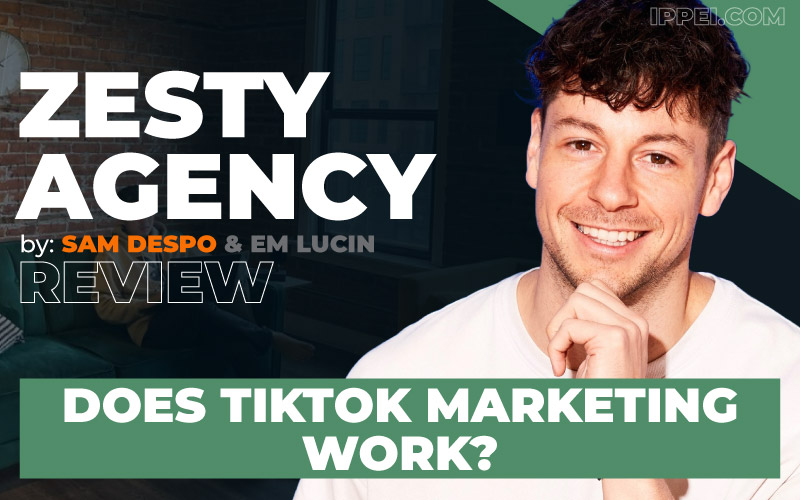Zesty Agency Review
Zesty Agency Review teaches you the secret sauce to grow engaged communities and generate sales on TikTok. It is a legit course that has many testimonials shown on their website and Instagram.
ZestyAI’s model-based platform uses real-world and synthetic data to predict how much cloud compute an app needs in any given time, buying or selling resources as needed. This reduces costs by reducing wasteful spending and optimizing cloud infrastructure usage.

ZestyAI uses AI to calculate a property’s risk and value. The system analyzes data, including public records, to determine the best price for an insurance policy. It also identifies potential natural disasters that could impact the property’s value. This service is available to both homeowners and businesses. Its users save an average of 30% on their insurance premiums. The company has a robust technical documentation and training videos. Its customer support team is available through email and Slack. ZestyAI is a great choice for SaaS companies looking to reduce their AWS costs.
The founders Sam Despo and Em Lucin claim that their course is the first TikTok community and content course in the world. They say that they will teach you the “secret sauce” in gaining followers and building a community that will earn you 6 to 7 digits. They also emphasize that creating a community is more important than creating viral TikToks.
This is not true. There are many other TikTok courses online that have been around for years, including the official TikTok Academy. In addition, the founders’ LinkedIn profiles show that they have been involved in other projects. These projects include social media management and other digital marketing services.
The company has a wide range of open remote jobs that offer flexible work options. Its employees rank its Perks and Benefits higher than other similar sized companies on Comparably. Its compensation is also higher than the industry average, making it an attractive option for remote workers. The company has a high-energy culture and has been recognized for its employee-centric workplaces. In addition, it offers excellent benefits and incentives for employees. Its leadership also supports its employees and provides an environment where they can grow professionally.
Z-VIEW
The software uses a hardware license key, called a dongle. If the dongle is not attached, the program will operate in demonstration mode and cannot be used for data analysis. To activate the program, insert the dongle into a USB port and follow the prompts. Once the program is active, it will check for the dongle every six months. When the dongle is present, the program will operate without restriction.
Z-VIEW provides a comprehensive set of tools for modeling and analysis. Its interface is easy to navigate, and the help system is extensive. It includes a full-text manual and online help files. The manual also includes a list of the functions that can be executed by clicking on the buttons and menus in the toolbar.
Aside from the ability to create models and analyze them, the software can also show 3D visualizations of models, allowing users to see their size. This can simplify decision-making processes in early stages of design, while providing imersive representation and deeper understanding. It can also speed up development times and reduce costs.
In addition to providing a variety of modeling and analysis capabilities, Z-VIEW can also import data from other sources. It is particularly useful for importing data from legacy systems that have been migrated to the cloud. The data can then be analyzed and exported to spreadsheets. This allows companies to improve their business operations.
Using Z-VIEW can help insurance carriers to make better decisions. It enables them to isolate their riskiest properties and improve their action rate on those properties. It can also help them reduce their accumulated risk and increase premium capture. Moreover, it can also provide them with more accurate property information.
The Underwriter Dashboard
In addition to enabling the right underwriting decisions, the Underwriter Dashboard provides insights to help drive efficiencies and process consistency. For example, it helps managers understand their overall deal and pipeline mix to drive the right underwriting focus and allocate resources accordingly. It also allows underwriters to track their performance and progress against targets. Ultimately, this can lead to higher levels of underwriting profitability and more transparent and consistent processes.
Insurance underwriting involves making high-impact, yet complex, decisions. Many underwriters are struggling to search, access, aggregate and understand their data to make decisions and improve profitability. They need a single pane of glass to gain insights, prioritize submissions and align risk and pricing.
Modern underwriting workbenches combine data optimisation, digitised documentation, automated workflows and AI-supported decision-making to empower teams with the tools they need. These tailored platforms can help streamline underwriting operations and reduce downtime for underwriters. Additionally, they can support adherence to regulations and provide better visibility of risk across the enterprise.
The Underwriter dashboard is designed for users in the underwriting team who review, order loss surveys, correspond with the agent, price quotes, create proposals, issue policies and process midterm amendments. It offers a real-time view of submissions and their status in the underwriting process. It enables users to sort and filter submissions by key information, such as loan type, rating, and location. Users can select Kanban or list views in the Underwriter Dashboard to provide a more targeted view of submissions in progress.
Sam Despo and Em Lucin are the founders of Zesty Agency. They have over 10 years of experience in digital marketing and have helped businesses achieve millions of dollars in sales. They have a large following on Instagram and Facebook and are known for their authenticity. They are also able to attract students who are looking for a reliable way to make money online.
Climate Risk Scores
In an era of increasing uncertainty about climate change, insurers and reinsurers are looking for ways to better evaluate their exposures. In particular, they are concerned that climatic trends that are not reflected in their models might expose them to unexpected risk. Consequently, the industry has developed several tools to identify regions or insurance portfolios that are particularly exposed to physical climate risks.
The first step in a risk assessment is to evaluate the potential impact of climatic hazards on a given region or company’s assets. This is done by developing a climate risk score for each location or asset type. These scores help quantify the risks associated with specific perils, such as fire, flood, and earthquakes. In turn, these scores can be used to develop loss estimates and model sensitivity.
While the results of this analysis are not perfect, they do provide an important starting point for insurers and reinsurers. Moreover, the process of developing these scores and rankings can be accelerated by facilitating access to open data. Commercial providers of these scores operate in a competitive market that fosters innovation but discourages sharing of underlying data. The availability of open data would shift the focus of this competition from proprietary data collection to superior data analysis.
A major source of uncertainty in these rankings is the low agreement between different scores. This is demonstrated in the scatterplots in Fig. 1, which display Pearson’s correlation and Kendall’s tau. These values are close to zero at the 1% significance level, indicating that there is very little correlation between scores on aggregate.
The differences between country scores are more striking. The EIB’s physical risk scores clearly show that some countries are more vulnerable to the direct physical impacts of climate change than others. These include sub-Saharan Africa, southern and southeast Asian economies that rely heavily on agriculture, and small island nations.





